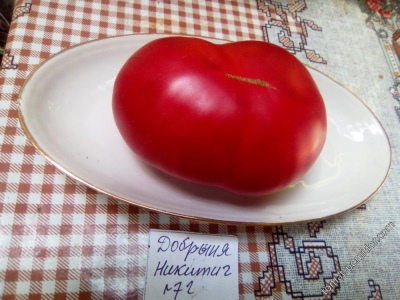
- Authors: Ognev Valery Vladimirovich, Maksimov Sergey Vasilievich, Klimenko Nikolay Nikolaevich, Kostenko Alexander Nikolaevich, LLC Agrofirm "POISK"
- Year of approval: 2008
- Category: grade
- Growth type: indeterminate
- Appointment: fresh consumption, for pickling and preserving
- Ripening period: mid-season
- Ripening time, days: 110-115
- Growing conditions: for open ground, for film greenhouses
- Bush size: tall
- Bush height, cm: 150-200
One of the most popular large-fruited universal tomatoes is the indeterminate variety Dobrynya Nikitich. Its fruits are used fresh, as an ingredient in summer and winter vegetable salads, it is suitable for cooking juices and sauces, for making tomato paste. The plant is grown in open ground, in film, glazed and polycarbonate greenhouses.
Breeding history
The variety was registered in the State Register of Breeding Achievements in 2008. The originators of Dobrynya Nikitich are breeders V. V. Ognev, S. V. Maksimov, N. N. Klimenko, A. N. Kostenko from LLC Agrofirma POISK.
Description of the variety
Tall (150-200 cm) bushes are covered with medium-sized light green leaves. Yellow flowers are collected in intermediate inflorescences. The fruits are attached to the articulated stalk.
Positive qualities of Dobrynya Nikitich:
unpretentiousness;
versatility;
strong immunity;
high productivity;
excellent taste and market indicators.
If we talk about the minuses, then they are not so weighty as to abandon the cultivation of Dobrynya. Tomatoes cannot be stored for a long time, much less transported, and they are not suitable for whole-fruit canning.
The main qualities of the fruit
Unripe large-fruited (200 grams or more) flat-rounded slightly ribbed fruits are colored deep green in an immature state. At the stage of technical and physiological ripeness, tomatoes acquire an intense dark pink color. The section is visible from the four seed chambers.
Taste characteristics
The fruits have a balanced pleasant taste, with a moderate amount of sugars and acids. Fleshy, medium-dense flesh is covered with thin skin, the dry matter content is at an average level.
Ripening and fruiting
The tomato belongs to the mid-ripening category - the approximate ripening period is from 110-115 days. Harvested in the second half of August - early September.
Yield
Yield indicators are considered average - up to 10 kilograms of tomatoes are harvested from one square meter.
The timing of planting seedlings and planting in the ground
Sowing seeds for seedlings falls on March 1-20, grown plants are planted in a permanent place after 2.5 months. More precise terms depend on the cultivation method (greenhouse or open ground) and the climatic features of the area.

Growing tomato seedlings is an extremely important process, because it largely depends on whether the gardener will be able to harvest at all. All aspects must be taken into account, from seedbed preparation to planting in the ground.
Landing scheme
The optimal planting pattern is 70x50 cm.

Growing and care
Dobrynya Nikitich is grown in seedlings. Before planting in a permanent place, tender seedlings are hardened, accustoming them to ambient temperature, daily changes and sunlight. For planting in open ground, choose places with good lighting, protected from drafts and cold winds. The acidity level of the soil should be neutral, acidic soils require deoxidation. This process is possible with dolomite or bone meal, gypsum, chalk, lime.
Dense loamy soils almost do not allow oxygen to pass to the root system of plants, therefore, gardeners are forced to constantly loosen. They solve the problem by introducing buckwheat or rice husks. Husk not only improves the structure of the soil, but also its composition, enriching it with microelements and vitamins. In addition, the husk attracts earthworms, therefore, contributes to an increase in the content of vermicompost.
Excellent predecessors of tomatoes are carrots, onions, garlic, cucumbers and legumes, as well as siderates. Tall tomatoes require stable support or trellis organization, as well as the formation of 1-2 stems, tying up as they grow and pinch. Prepared holes are enriched with organic matter, complex mineral fertilizers, wood ash. After planting the seedlings in the holes in accordance with the proposed scheme, the soil around the seedling is compacted, well spilled with warm water and loosened the next day. Further care consists in timely watering, weeding, loosening, hilling, and top dressing.




A plant needs different micronutrients at each stage of growth. All fertilizers can be divided into two groups: mineral and organic. Folk remedies are often used: iodine, yeast, bird droppings, eggshells.
It is important to observe the rate and period of feeding. This also applies to folk remedies and organic fertilizers.
Disease and pest resistance
The variety has strong immunity, which allows it to successfully resist late blight, tobacco mosaic virus (TMV), spot and bacteriosis, as well as most diseases inherent in the nightshade group of plants. He will not be able to cope with aggressive pests on his own, however, preventive treatments with insecticides and fungicides successfully solve this problem.


Resistant to adverse weather conditions
Dobrynya Nikitich is able to withstand the daily temperature drops in the summer period, as well as short dry and rainy periods.
Growing regions
The variety is intended for cultivation both in warm areas with a long summer period (Krasnodar Territory, Astrakhan Region, Crimea, Moldova, Central Black Earth Region, North Caucasian District), and in more temperate latitudes. These are the northern, northwestern, central, Volgo-Vyatka, Middle Volga, Lower Volga, Ural, West Siberian, East Siberian, Far Eastern regions.

























































































